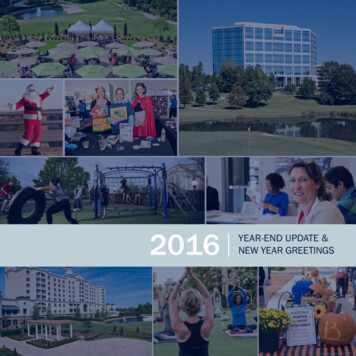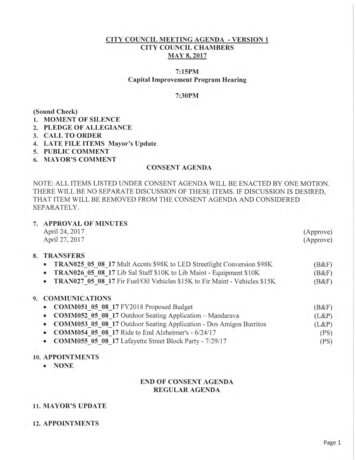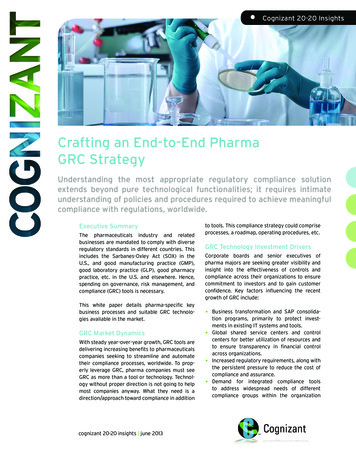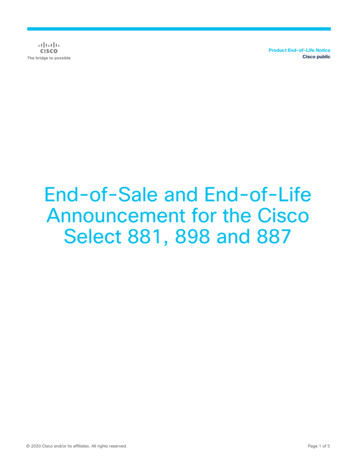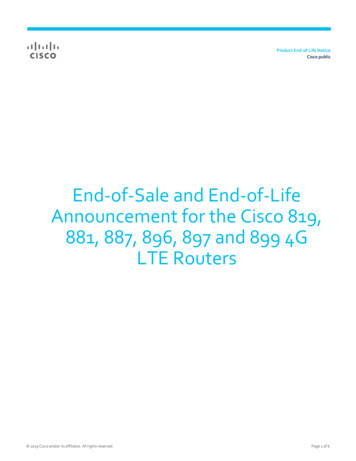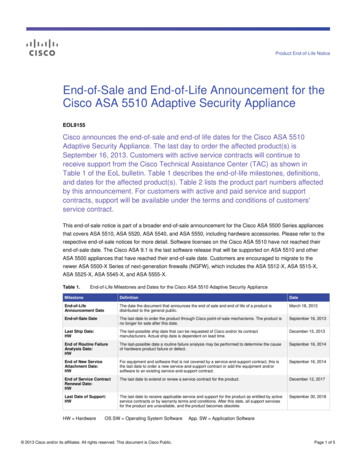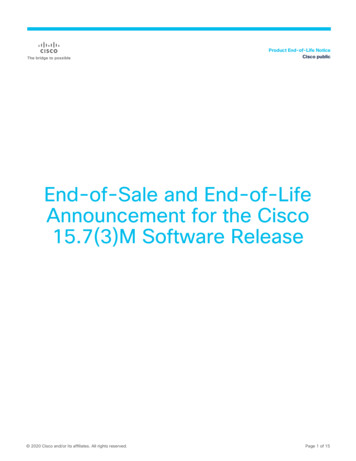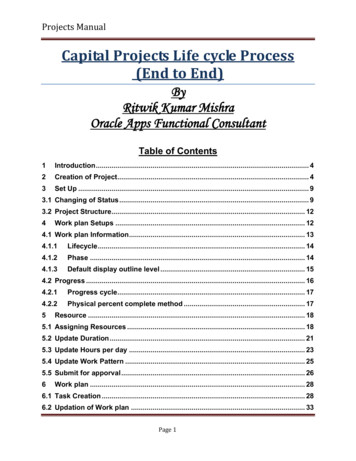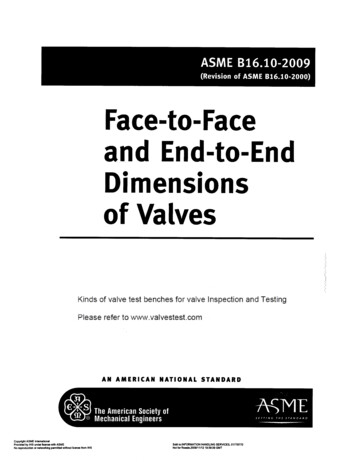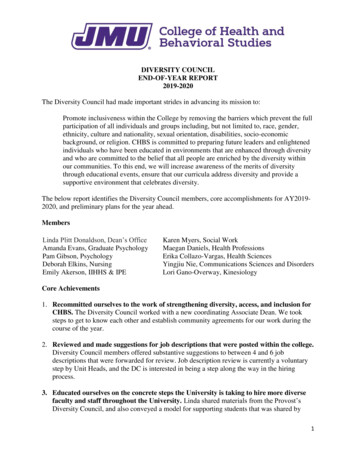
Transcription
DIVERSITY COUNCILEND-OF-YEAR REPORT2019-2020The Diversity Council had made important strides in advancing its mission to:Promote inclusiveness within the College by removing the barriers which prevent the fullparticipation of all individuals and groups including, but not limited to, race, gender,ethnicity, culture and nationality, sexual orientation, disabilities, socio-economicbackground, or religion. CHBS is committed to preparing future leaders and enlightenedindividuals who have been educated in environments that are enhanced through diversityand who are committed to the belief that all people are enriched by the diversity withinour communities. To this end, we will increase awareness of the merits of diversitythrough educational events, ensure that our curricula address diversity and provide asupportive environment that celebrates diversity.The below report identifies the Diversity Council members, core accomplishments for AY20192020, and preliminary plans for the year ahead.MembersLinda Plitt Donaldson, Dean’s OfficeAmanda Evans, Graduate PsychologyPam Gibson, PsychologyDeborah Elkins, NursingEmily Akerson, IIHHS & IPEKaren Myers, Social WorkMaegan Daniels, Health ProfessionsErika Collazo-Vargas, Health SciencesYingjiu Nie, Communications Sciences and DisordersLori Gano-Overway, KinesiologyCore Achievements1. Recommitted ourselves to the work of strengthening diversity, access, and inclusion forCHBS. The Diversity Council worked with a new coordinating Associate Dean. We tooksteps to get to know each other and establish community agreements for our work during thecourse of the year.2. Reviewed and made suggestions for job descriptions that were posted within the college.Diversity Council members offered substantive suggestions to between 4 and 6 jobdescriptions that were forwarded for review. Job description review is currently a voluntarystep by Unit Heads, and the DC is interested in being a step along the way in the hiringprocess.3. Educated ourselves on the concrete steps the University is taking to hire more diversefaculty and staff throughout the University. Linda shared materials from the Provost’sDiversity Council, and also conveyed a model for supporting students that was shared by1
Linette Watkins, the Unit Head for Chemistry. Learning about University policies andpractices were important to consider how to best use limited CHBS resources to supplementwhat the University was doing to address diversity issues. In this process, we also asked theVice Provost for Diversity and Inclusion to share with the council, literature in the followingareas: Documentation for the reasons why faculty diversity is so important. It seems obviousthat having diverse perspectives would add to a better and richer academic experience,but what is the data and what are other outcomes (e.g., retention of students of color, arethere other learning outcomes?)Best practices for under-represented faculty retention and supportBest practices for supporting under-represented faculty in their journey toward tenure andpromotion.Best practices for retaining and supporting students from under-represented populations?An annotated bibliography and some additional materials on some of these topics was sharedin April 2020. These will be important resources for the work of the Diversity Council goingforward. We will also remain in touch with this office for updates to this resource list.4. Brainstormed and submitted names of noted scholars in the areas of diversity ascandidates for the invited Visiting Scholars speaker, with the top recommendationbeing Dr. René Salazar. These names included: Dr. René Salazar, Assistant Dean for Diversity, Department of Medical Education,University of Texas at Austin - Dell Medical (https://dellmed.utexas.edu/directory/renesalazar) Author of 2019 paper in Family Medicine, entitled, The Efficacy of anAntioppression Curriculum for Health Professionals Dr. M. Normal Oliver, co-author of research on how physicians’ implicit views aboutrace affect clinical decisions, and currently State Health Commissioner of VDH, formerlyDeputy Commissioner for Population Health for VDH. Note: Susan Luparell, author of research on incivility in health care contexts with a focus onhow academia must prepare today’s students for difficult clinical settings, currently onfaculty at Montana State University, Bozeman. Derald Wing Sue, Professor of Psychology and Education at the Columbia UniversityTeachers College. Among many publications on racism and microagressions, he authoredthe book Race Talk: Conspiracy of Silence.5. Drafted and deployed a survey of CHBS faculty and staff related to strengths/needsaround faculty diversity. A copy of the final survey is provided in Appendix A. DiversityCouncil members discussed the raw data at the April 6, meeting and Lori Gano-Overway andPam Gibson will conduct a deeper content analysis of the survey findings and a preliminaryset of recommendations will follow from that.2
6. Convened an emergency meeting in the summer to respond to renewed consciousnessabout anti-black racism, marginalization of people of color, and structural oppression.In the wake of the murder of George Floyd, one of a series of black people murdered bypolice that caused protests nationwide, the Diversity Council held an emergency meeting onJune 8th to discuss actionable steps we could take now to address racism in our College.Some of the ideas shared included: Diversity Toolbox: Each member of the Diversity Council will compile of list ofresources related to diversity that will be mailed to the CHBS on the second Monday ofthe month. The first one will be sent in June 2020, with a statement from the DiversityCouncil sharing a list of resources and our plan for the toolbox going forward.Subsequent e-mails will be sent each month of the academic year, except for December.We will also post these resources on our website and label them as 1.0, 1.1, 1.2, and thennext year we could start with 2.0, 2.1, 2.2, and so on. College-Level Affiliation Groups: Social work has student affinity groups, and the DCmembers felt it would be good to encourage all units to form these affinity groups. Collecting Racist Incidents on Campus: It would be helpful to have a place ormechanism on campus for students and faculty/staff to report incidents of racism. Almostlike a suggestion box, but something that would help us track these incidents, and alsorespond to those incidents in supportive and meaningful ways. Rapid Response Network: The idea of forming a rapid response network wasmentioned. This would be a network of people who would be available to respond at amoment’s notice when an incident occurs. Safe Zone Training Related to Racism: Someone mentioned that we should trainfaculty and staff on how to intervene and respond to racist incidents on campus that theyobserve. Those who have been trained should have some designation so people know thatit is a ‘safe faculty/staff’ member to talk to. They mentioned modeling this after the safezone training that’s offered to address sexual assault. Diversity/Inclusion as part of Faculty Annual Plan and Annual Review: One way toadd accountability for diversity/inclusion among faculty is to have ask faculty to submitideas for what they will be doing over the course of the year to address their knowledge,skills, and/or behavior related to diversity and inclusion, as there is accountability forresearch, teaching and service. Speaker: Inviting a speaker to campus to speak about health-related diversity issues. Training: Provide training for faculty on unconscious bias and other topics related todiversity and inclusion. College Grants: As funds are available, tie college grant opportunities to anti-racism,diversity, and inclusion.3
Be a Resource for the Community: consider ways that CHBS can be a resource for thelocal community to education them about diversity and inclusion or to help systemicchange occur in our surrounding area to be a more welcoming place for all. Book Club: Select a book (from the Diversity bookshelf or elsewhere) and start a bookdiscussion group. The CoE did something like this that was open to the whole university facultycommunity. We could start with our own group and consider expanding this to other faculty,staff, and students.The Diversity Council will meet again on July 8th to continue to talk about actionable ways toaddress anti-black racism and intersectional approaches to helping our community become morewelcoming and inclusive.Preliminary Plans for 2020-2021In addition to following up on the ideas mentioned in the previous section, the Diversity Councilgenerated some general areas to focus their efforts over the next year. They identified three areasprimarily related to faculty at CHBS: Hiring and Recruitment; Retention; and Thriving.1. Hiring and Recruitment:a. Develop communication mechanism between the search committees’ efforts to seekcandidates from diverse backgrounds and the Diversity Council.b. Develop communication mechanisms between the University-level grant opportunities toenhance diversity and CHBS.c. Be more aware of how search committees are using the registry’s that we subscribe tothat we use to invite candidates from underrepresented populations to apply for openpositions.d. Continue to look at search announcements (job descriptions)2. Retention:a. Ensure tenure and promotion criteria are clearly established in each unit so the candidateshave clear expectations about what is expected. One faculty member shared that thosecriteria shifted after she was hired after she had already vetted what was ‘acceptable’research during her interview process.b. Identify intentional ways to check in with faculty, invite them to social gatherings, andconnect them with groups that would be supportive and help them feel connected.c. Ask the faculty affinity group reach out in personal ways to new faculty whose socialidentity includes that same dimension of difference.d. Address training needs for people at all levels, faculty, administration, staff. All are partof creating a welcoming and inclusive culture.3. Thriving:4
a. Ensure faculty from under-represented groups aren’t overloaded in being asked to serveon committees or represent a ‘diverse perspective’ (i.e., protect their time so they canteach and engage in scholarship)b. Compile a list of fun things to do in Harrisonburg that show that the city celebratesdiversity (international festival, African-American festival in June, Latino festival, and soon)c. Help search committees develop language to share experience of living in thesurrounding area without putting it down.d. Assign inter-department buddies among people who start at the same time so build in asupport system for people who start together.e. Bring faculty together for informal ways of being together (with refreshments).f. We recognized the challenge of doing more with less money to achieving some of theideas.STAR Objectives Realized Through Diversity Council EffortsThe initiatives being advanced through the CHBS Diversity Council connect to many of the CoreQualities and Goals articulated in the JMU Strategic Plan, but specifically to the third corequality, Access, Inclusion, and Diversity, and most of its associated goals. Below, we describethe connection.Key Goal3B: The university will expand access, buildingnew bridges to cross existing socioeconomic,geographic learning and/or physical barriers toparticipate in academic pursuits and campusactivities.Diversity Council ContributionThe Diversity Council is poised to help thecollege and academic units expand access andcross barriers to help all people equitableparticipate in and thrive in academic pursuits.Some of the ideas generated at the summermeeting will help to address some of thesebarriers and access points.Goal 3C: The university will show evidence of acontinuously improving environment that iswelcoming and inclusive, such that events,messages, symbols, and services express mutualrespect.Goal 3D: The university will continue personaland professional development related toenhancing understanding of diversity whileleveraging increased diversity throughuniversity/community partnerships.The Diversity Council has laid the foundationfor its work to act and implement particularideas to improve the environment for allpeople.Goal 3F: The university will infuse a value andculture of diversity into the primary teaching,A core focus for the Diversity Council wasrecognizing the need for training but alsorealizing that many faculty were alreadydoing strong anti-racist, anti-oppressive work.Therefore, we conducted the survey to engageideas around strengths and needs to enhancethe CHBS environment around diversity,access, and inclusion.The Diversity Council is recommending thatactions toward cultivating knowledge, skills,and abilities around diversity, access, and5
research and service approaches of academicunits.inclusion be included in faculty annual plansand reviews. This is one of several ideas tohelp institutionalize efforts to enhance facultyknowledge, consciousness and ability to acton these issues.6
Appendix ADiversity Council Survey (deployed in March 2020)Overview: The College of Health and Behavioral Studies (CHBS) strives to be a welcoming andinclusive community where all people can thrive. We believe that you are the heart of theuniversity, and the manner in which all of us work together to create communities of care, respect,and inclusivity will help determine the degree to which people feel welcome and flourish ascolleagues or as students.Introduction:The CHBS Diversity Council invites you to participate in a survey regarding your practices insupporting and advancing diversity and inclusion at JMU. The intent of this survey is twofold: 1)to find out what strategies you are currently using and implementing to create safe and inclusivespaces for colleagues and students, and 2) to identify areas where faculty and staff could usemore support in creating safe and inclusive spaces for all. Information from the survey will assistthe CHBS Diversity Council in identifying strategies to enhance diversity, access, and inclusionin the CHBS community.This survey consists of seven questions. When providing your responses, please be mindful thatindividuals can be diverse in many dimensions, such as race, ethnicity, national origin, gender,gender identity, sexual orientation, age, health conditions, abilities, religion, socio-economicstatus, education, and so on. Please also be mindful that inclusion is the act of intentional andongoing engagement with people of diverse backgrounds to enhance their sense of belonging tothe community, and can be accomplished in a variety of ways.Finally, this survey is entirely confidential. Results will be reported in the aggregate and notconnected to any particular person.Survey Questions:Before starting the survey, please identify yourself as one of the following members of the CHBScommunity:a.b.c.d.Faculty (This includes full-time AP and Instructional Faculty)Part-time Faculty/Adjunct facultyStaffOther1. What specific things do you do that support and advance diversity and inclusion wheninteracting with your colleagues (e.g., administrators, faculty, staff)?2. What specific things do you do that support and advance diversity and inclusion wheninteracting with students?7
3. To support and advance diversity and inclusion within the CHBS, I believe the following isneeded:4. To increase my knowledge of diversity and inclusion, I have done or do the following (selectall that apply, and for each item selected, please provide examples.)i.ii.iii.iv.v.vi.vii.Attend trainingsSeek information online (e.g., documentary, Ted Talk, webinars)Engage in personal reading (please suggest any books you would recommend)Read one or more of the books on the CHBS diversity bookshelfEngage with people and/or communities who are different than meParticipate in study abroad opportunitiesOther5. What else has been helpful to you in strengthening your knowledge, skills, and behaviors inunderstanding and/or addressing issues related to diversity and inclusion?6. What additional support do you need to strengthen your knowledge, skills, and behaviors asit relates to diversity and inclusion?7. If you would like to offer yourself as a resource to the CHBS Diversity Council, please sendan e-mail Linda Plitt Donaldson, plittdlx@jmu.edu indicating the ways you think you couldbe helpful to the group.You may also provide your name and EID as part of this survey to offer yourself as aresource to the CHBS Diversity Council.EIDPlease describe how you might be able to contribute to the work of the CHBS DiversityCouncil:Thank you.8
Amanda Evans, Graduate Psychology Pam Gibson, Psychology Deborah Elkins, Nursing Emily Akerson, IIHHS & IPE Karen Myers, Social Work Maegan Daniels, Health Professions Erika Collazo-Vargas, Health Sciences Yingjiu Nie, Communications Sciences and Diso
